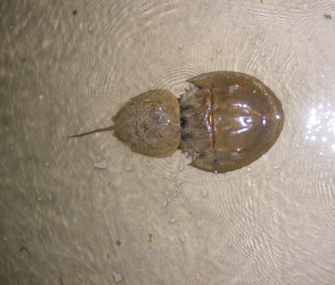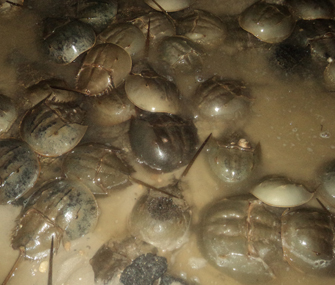Why You Should Care About Horseshoe Crabs
Published on April 23, 2014

If you vacation at the shore on the East Coast, you may have seen horseshoe crabs washed up on the beach — and you may have found them a little creepy. They're up to a foot wide; they've got that long, pointy tail; and underneath, there are all those legs!
Well, the strange-looking animals can't hurt you. In fact, they have actually helped you. They're critical to the pharmaceutical industry and play an important role in the ecosystem. And if you want to see a whole lot more of them, now's the time. You can even help researchers who keep track of the numbers of these creatures.
A Misnomer
Horseshoe crabs aren't actually crabs. "They're more closely related to spiders and scorpions," horseshoe crab expert Dr. William Hall says. There are four species in the world, one of which lives on the East Coast, from Maine to the Yucatán Peninsula, with the majority of the population in the middle of the range, in Delaware. The other species live in the Western Pacific.
If they look prehistoric, there's a reason: They've gone unchanged for a very long time. The species of horseshoe crab alive today have been around for 30 to 35 million years, according to Hall. And though they look a bit intimidating, they can't harm you. "The tail is not there to stick you; it's there to flip them over," Hall says. "They have claws underneath, but you can put a finger in a claw and they can't squeeze it hard enough to hurt you."
Important to Health and the Environment
Horseshoe crabs are essential to making a product that is used to test medical products for contamination. The product, called Limulus amebocyte lysate, or LAL, is made from the blood of horseshoe crabs, which are captured from the wild, then returned to the ocean after their blood is drawn. LAL is used in a test that detects bacterial endotoxins. "Any drug that crosses a cell membrane (like an injection of penicillin), a tooth implant, a hip implant, fluid that goes in your eye for your contact lens — [they all have] to be tested to be free of bacteria, and this is the most sensitive test we have," Hall says. "That product, depending on whom you talk to, is anywhere from a $100 million to a $150 million industry a year."
The crabs are also important to the ecosystem, largely because of their spawning behavior. In the spring, they come ashore in huge numbers to lay eggs. "When you get out there on a night when they're really coming ashore, you could see 10,000 or 15,000 crabs," Hall says.
The peaks occur with the new moon and the full moon, when the tide is at its highest, says Eric Buehl of the Delaware Center for the Inland Bays. "At high tide, the female moves in and kind of burrows in and starts laying eggs," he says. "The males have special claws that are able to attach to the females' shells, and they ride along. And as she's laying eggs, they're fertilizing them."
The eggs provide food for other animals at a crucial time. "There are a number of bird species that time their travels in their migration north to the spawning because it's a major food source," Buehl says. Hall explains that the eggs and young crabs are also important food for other marine creatures. "They're a huge source of protein for fish recovering after the winter, and once the eggs hatch, the juveniles are food for juvenile fish." He says it's not unusual to find the crabs inside sharks, rays and marine turtles.

Tracking the Crabs
The spawning of horseshoe crabs is an amazing spectacle — and an opportunity for scientists to keep track of the numbers of the important animals. They've done so since 1990, when a group led by researchers, including Hall, conducted the first horseshoe crab survey with the help of volunteers. The idea of conducting a census had good timing, because soon a new threat appeared: The bait industry started to collect the crabs in huge numbers. "They were coming to the beaches and hauling off tractor-trailer loads of 10,000 at a time," Hall says.
When the census showed the population was declining, a management plan was created regulating the number of animals that could be harvested. Hall says that last year's survey finally gave some indication that the population is recovering. "That's what we figured it would take," he says, "a minimum of 10 years of management for the population to recover, since it takes 10 years for them to mature."
How You Can Get Involved
Vounteers can help with the surveys Hall and Buehl conduct by going to their websites and getting in touch with the team leaders who monitor the beaches to know when the spawning starts.
Buehl says that it's simple to get involved with his group's census. "The training can occur onsite — it's pretty rudimentary. Watch for a few minutes, and you can learn to identify male from female and count," he says. The count takes place after dark, so you're encouraged to wear a headlamp to keep your hands free. If you're not comfortable handling the crabs, you can help tabulate data or lay out the rope that marks where to count or even just observe.
Hall says that his group conducts surveys 12 nights per year in the Delaware Bay and gets a minimum of 150 to 200 volunteers annually, some of whom think it's worth quite a trip to see this natural phenomenon. "People have come from all over," he says. "We've had people come from as far away as California, England and Germany."
Other Ways to Help
If your trips to the beach don't coincide with crab census season, there are other ways to help horseshoe crabs. Scientists tag some crabs, and if you find one, you can report it. "The tags help us to find out where they're going and understand their whole life cycle," Buehl says. "When they go out into deep water and bury themselves in the winter, where do they go? And do we need to be careful about how we're managing those areas?"
Also, if you see a live crab upside down on the beach, flip it over. "If they're left there, they either dry out or the gulls eat them," Hall says. Although the tail is there to flip them back over in these situations, it doesn't always work — for instance, if the sand is too wet for the tail to get a good grip.
And if nothing else, just appreciate this ancient animal that's so unexpectedly important. "Here's something that people see wash up on shore and back away from and think it's going to sting them with its tail," Buehl says, "and most people don't realize they've benefited from something these creatures provide, which is making sure that medications are free from contamination."
Where to Volunteer
Horseshoe crab survey volunteer opportunities in the Delaware Bay (Delaware and New Jersey):
Horseshoe crab census volunteer opportunities elsewhere:
More on Vetstreet.com:
- Video: Puppy Makes Friends With a Crab
- Meet the Largest Mammal You Have Never Heard Of
- 8 Most Dangerous Plants for Cats and Dogs
- 10 Strange Dog Behaviors Explained





